Trees Birds Mammals Fish Amphibians Reptiles
Wild Algarve
Bookshop
Agrocybe praecox (Pers.) Fayod - Spring Fieldcap
Phylum: Basidiomycota - Class: Agaricomycetes - Order: Agaricales - Family: Strophariaceae
Distribution - Taxonomic History - Etymology - Identification - Culinary Notes - Reference Sources
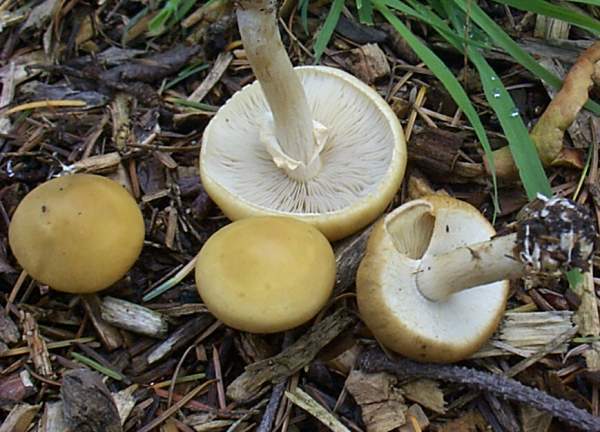
In spring and early summer these attractive but very variable fungi emerge in woods and beside hedgerows, often carpeting paths and flowerbeds that have been spread with wood chippings.
Distribution
This early-fruiting mushroom is an uncommon but far from rare find in Britain and Ireland. Spring Fieldcaps occur throughout Europe and are found also in North Africa and parts of North America.
Commonly known as the Spring Fieldcap or, in some older field guides, as the Spring Agaric, Agrocybe praecox is one of a complex group of fungi that are very difficult to separate in the field. Note: In some field guides this mushroom is recorded in the family Bolbitiaceae.
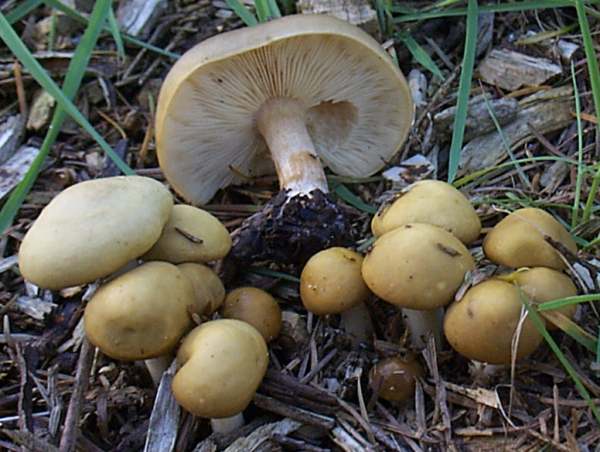
Taxonomic history
When Christiaan Hendrik Persoon first described this mushroom in 1800 he named it Agaricus praecox. (Most of the gilled fungi were initially placed in a giant Agaricus genus, now redistributed to many other genera.)
The currently accepted scientific name Agrocybe praecox dates from 1889, when Swiss mycologist Victor Fayod (1860 - 1900) transferred it to the new genus Agrocybe that he established with Agrocybe praecox as the type species.
Synonyms of Agrocybe praecox include Agaricus praecox Pers., Agaricus togularis Pers., Agaricus gibberosus Fr., Pholiota praecox (Pers.) P. Kumm., Pholiota togularis sensu Gillet, Agrocybe gibberosa (Fr.) Fayod, and Togaria praecox (Pers.) W.G. Sm.
Etymology
'Fieldcap' is derived from Agro-, of fields, and -cybe, head or cap, and is therefore a direct translation of the generic name Agrocybe. The specific epithet praecox is a Latin word meaning 'developing or appearing early'; it has the same origin as the adjective 'precocious'.
Identification guide
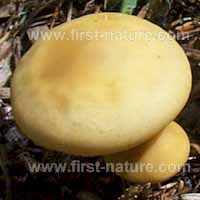 |
Cap
3 to 9cm in diameter. Cream or pale tan;
convex and slightly greasy when young, expanding to almost flat with a
smooth surface that sometimes wrinkles and crazes when old.
The cap flesh is firm and almost white. |
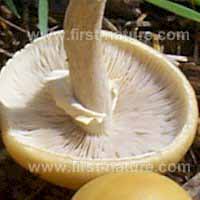 |
Gills
Adnate or adnexed to almost free, the gills are pale buff at
first becoming dirty brown as the spores mature.
Stem
Almost white when young, becoming browner with age, the stem has a white
ring that discolours to brown as the spores mature and fall. The stem
is 5 to 15mm in diameter and 4 to 7cm tall; its base is slightly swollen. Internally, the fibrous stem is solid and has buff flesh that ages light brown. |
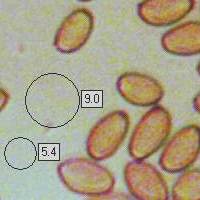 |
Spores
Ellipsoidal to ovoid, smooth, 7.5-10 x 5-6μm, with a prominent germ pore.
Spore print
Brown.
|
Odour/taste |
Slightly mealy odour; nutty but rather bitter taste. |
Habitat & Ecological role |
Scattered or in small tufts at woodland edges,
and beside wood chip paths and on rotting straw. |
Season |
May to August; occasionally in
September. |
Similar species |
Agrocybe molesta (synonym Agrocybe dura), which also occurs in
spring, is paler and has an umbonate cap that usually cracks when fully expanded.
Cyclocybe cylindracea (synonym Agrocybe cylindracea) grows on stumps of poplars and willows. |
Culinary Notes
Agrocybe praecox is considered edible if well cooked, but it is said by some to retain a bitter taste and is of very poor quality. Most field guides say that this group of fieldcap fungi is best avoided when gathering mushrooms to eat as they are easily confused with a number of seriously toxic toadstools.
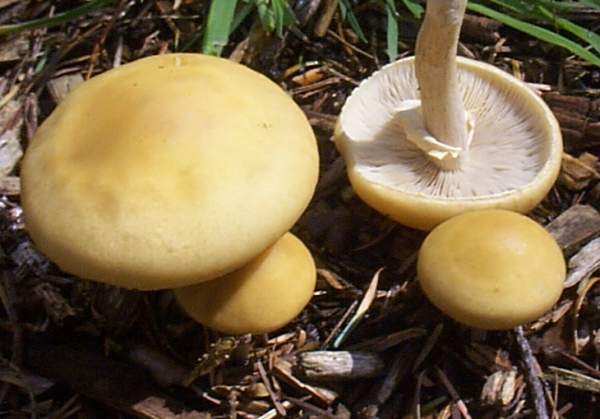
Reference Sources
Fascinated by Fungi, 2nd Edition, Pat O'Reilly 2016, reprinted by Coch-y-bonddu Books in 2022.
Marcel Bon, 1980: Revision du Genre Agrocybe Fayod. Bulletin trimestriel de la Fédération Mycologique Dauphiné-Savoie, 76: 32-36. Bulletin de la Fédération trimestriel Mycologique Dauphiné-Savoie, 76: 32-36.
Henning Knudsen & Jan Vesterhout (2008). Funga Nordica. Copenhagen: Nordsvamp. p. 828.
BMS List of English Names for Fungi
Dictionary of the Fungi; Paul M. Kirk, Paul F. Cannon, David W. Minter and J. A. Stalpers; CABI, 2008
Taxonomic history and synonym information on these pages is drawn from many sources but in particular from the British Mycological Society's GB Checklist of Fungi.
Top of page...
Fascinated by Fungi. Back by popular demand, Pat O'Reilly's best-selling 450-page hardback book is available now. The latest second edition was republished with a sparkling new cover design in September 2022 by Coch-y-Bonddu Books. Full details and copies are available from the publisher's online bookshop...